Top>Research>Shimbun Gakuin and the aspirations of Shinjiro Yamane
 Index
Index
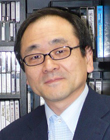
Ryoichi Matsuno [profile]
Shimbun Gakuin and the aspirations of Shinjiro Yamane
Ryoichi Matsuno
Professor, Faculty of Policy Studies, Chuo University
Areas of Specialization: Journalism and Media Studies
Prewar journalist training institute
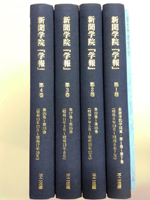
Photograph 1: Reprint of Gakuho originally published by Shimbun Gakuin (Fuji Shuppan Publishing)
Two well-known journalists in prewar Japan are Nyozekan Hasegawa and Sojinkan Sugimura. Both men were Chuo University alumni. However, we must not forget another Chuo alumni—Shinjiro Yamane. Yamane founded Shimbun Gakuin, which was the first school to focus on cultivating journalists in prewar Japan. Indeed, it can be said that these three men built the foundations for journalism in prewar Japan. Recently, Fuji Shuppan Publishing released a reprint of Gakuho (total of 33 volumes), a research bulletin originally published by Shimbun Gakuin. I had the honor of commenting on the reprint.
Who was Shinjiro Yamane?
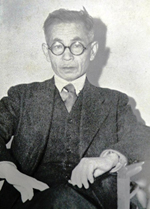
Photograph 2: Shinjiro Yamane, founder of Shimbun Gakuin (photograph provided by Kojiro Yamane)
Shimbun Gakuin was founded by Shinjiro Yamane (1884-1952; graduated from the Chuo University Faculty of Law in 1907), who also held various posts including managing editor (later vice-president) of Kokumin Newspaper Company, chairman of Japan Broadcasting Company, chairman of the Japan Newspaper Publishers and Editors Association, and editorial advisor to the Chubu Nippon Newspaper. In 1931, the same year as the Manchurian Incident, Shimbun Gakuin was founded in Kanda Misaki-cho (later Ginza) with supporters including Soho Tokutomi and the executives of various newspaper companies and news agencies. Classes started from April 1932. In 1934, Shimbun Gakuin became affiliated with the Japan Newspaper Publishers and Editors Association, and the association began to provide financial support. Even as Japan became increasingly involved in war, the school continued to exists for about 11 years. However, it was forced to close in 1942 due to worsening wartime conditions. Shimbun Gakuin provided education for small groups of select students in order to cultivate expert journalist and managers. The school produced a total of 332 graduates, of which 70% forged successful careers at newspaper companies, news agencies, broadcasting companies, and other areas of the mass media. Furthermore, Shimbun Gakuin accepted foreign students from the Korean Peninsula and Taiwan, which were Japanese colonies at the time. After the end of World War Two, these foreign students returned to their native countries and became executives in the media industry.
Purpose of foundation
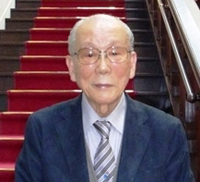
Photograph 3: Kojiro Yamane, son-in-law of Shinjiro Yamane (photograph taken in 2010; Kojiro was 96 years old at the time)
The names of many former mass media executives can be found among the founders and supporters of Shimbun Gakuin. In addition to founder Shinjiro Yamane, there were 27 supporters including Soho Tokutomi, Taketora Ogata (Managing Editor, Tokyo Asahi Shimbun Company), Hoshio Mitsunaga (President, Japan Telegraphic Communication Company), Matsutaro Shoriki (President, Yomiuri Shimbun Company), Hironao Seki (President, Hakuhodo Incorporated) and Sojinkan Sugimura (Advisor, Tokyo Asahi Shimbun Company). It is clear that the Japanese mass media at that time was united in supporting the cultivation of journalists at Shimbun Gakuin.
The following was written regarding the purpose of founding the school (I revised the statement into modern Japanese).
“It has been 60 years since the publication of the first Japanese newspaper. Moreover, there are now more than 2,000 related corporations. The function and authority of such corporations have an immeasurable influence on modern society. Shimbun Gakuin was founded to convey the importance of newspaper research and the great meaning in cultivating newspaper employees.”
Why did mass media executives agree with the organized cultivation of journalists as envisioned by Shinjiro Yamane and support the founding of Shimbun Gakuin? Shinjiro Yamane once said that “journalists are both born and made.” In other words, although journalism requires talent, overreliance on that talent creates the risk of mistaken reporting. In Yamane’s view, a truly outstanding journalist is one who has undergone repeated training and acquired the experience in addition to talent.
Yamane also showed respect for Dr. Walter Williams, the founder of the School of Journalism at the University of Missouri (USA). Yamane considered this School of Journalism as the first institution in the world to establish a clear policy for creating journalists. Shimbun Gakuin’s goal of cultivating both journalists and managers was modeled after the University of Missouri, not after the Columbia University model which focused almost exclusively on training journalists.
Why did Yamane found Shimbun Gakuin in 1931? In 1930, Yamane left his position of Vice-President at Kokumin Newspaper Company. According to Yamane’s son-in-law Kojiro Yamane (a Chuo alumnus), Shinjiro was initially offered the opportunity to travel to Western countries by Nagafumi Aruga, a powerful figure in the Mitsui financial group. Aruga even offered to pay for travel expenses. However, Shinjiro gave the following reply: “The age of journalism is coming. Instead of traveling, I would like to use your funding to cultivate journalists.” Aruga agreed to this proposal, and provided capital for the opening of Shimbun Gakuin. Kojiro has testified that the funds provided by Aruga at that time were 200,000 yen.
Curriculum at Shimbun Gakuin

Photograph 4: Gakuho (Vol. 32), published by Shimbun Gakuin
Schools have regulations, and Shimbun Gakuin was no exception. Article 1 of the regulations stated the school’s purpose as follows: “Shimbun Gakuin seeks to provide journalists and managers (hereinafter referred to as “employees”) of newspaper agencies with theoretical and practical education, and to conduct surveys and research regarding newspapers.”
Shimbun Gakuin was composed of two courses; an Editing Course and a Management Course. This is thought to be modeled after the University of Missouri. The term of study was one year and classes were held in the evening. 33 different subjects were established, and required subjects were set for each course. The Editing Course consisted of 21 subjects including Introduction to Newspapers, History of Speech, The Newspaper Act, General Editing Theory, General Management Theory, Composition Studies, Article Studies, Practical Article Writing, Photography, Engineering Studies, and Business & Second-Business Theory. The Management Course also consisted of 21 subjects including Introduction to Newspapers, The Newspaper Act, General Editing Theory, General Management Theory, Business & Second-Business Studies, Composition Studies, Sales Studies, Advertising Studies, Drafting & Design Methodology, Engineering Studies, and Newspaper Accounting.
One elective course which was offered was “Tours & Extracurricular Lectures.” In addition to newspaper companies, new agencies and the Japan Broadcasting Company, tours also visited sites of news reporting such as the Prime Minister’s Official Residence, Metropolitan Police Department, courts, prisons, and the Bank of Japan, as well as cultural facilities such as the Kabuki-za Theater, the Nikkatsu Tamagawa Movie Studio, and Korakuen Stadium. Moreover, the extracurricular lectures featured extremely realistic and practical topics including reports from war correspondents who had conducted reporting at the frontline of the Sino-Japanese War, reports from Manchukuo and the Lytton Commission, lectures on broadcasting industries and reporting agencies, overviews of American journalism, and journalist activities in relation to the Hindenburg Disaster.
Actual contents from lectures
When looking only at a list of subjects, it appears that the main focus of Shimbun Gakuin was practical and realistic cultivation of journalists. However, actual lecture contents contained ideas which would have led to arrests if a military policeman had heard the lectures. According to Kojiro’s first-hand account of the lectures, there were reports on the tragic conditions caused by war, on evil acts perpetrated by the Japanese military, and on other topics which could not be included in written articles. Furthermore, war correspondents returning from the frontlines revealed actual conditions that were completely different from the announcements of Imperial Headquarters. “Ultimately, participants decided that Japan should not be at war,” recalled Kojiro. He also told that lecture contents were completely uncensored. Although Shimbun Gakuin appeared to comply with national policy such as The Newspaper Act and the wartime regime, the actual lecture contents were surprisingly liberal.
Enrollment requirements and instructors at Shimbun Gakuin
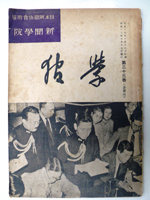
Photograph 5: The final volume of Gakuho (Vol. 33)
Enrollment requirements at Shimbun Gakuin for regular students were as follows: “Only individuals who have graduated from a school according to the Professional School Ordinance or a school which is at least equivalent to the above school, or individuals who have been deemed by Shimbun Gakuin as eligible to participate in classes.” Through these relaxed enrollment requirements, the school sought to gather outstanding students. These requirements also made it possible to accept students from the Korean Peninsula, Taiwan, and other countries which were Japanese colonies at that time. Indeed, the liberal stance and open attitude of Shimbun Gakuin were embodied in its policy of gender equality and of equal acceptance for students from Japanese colonies.
Instructors were executives from newspaper companies, news agencies, advertising agencies, corporate advertising departments, police departments and other organizations. At the time of the school’s founding, the majority of students were university students. However, in the school’s later years, nearly half of students were already employed at newspaper companies. During wartime, newspaper companies did not have the time to train young employees, so Shimbun Gakuin fulfilled the role of cultivating journalists.
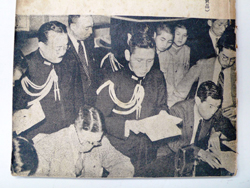
Photograph 6: The photograph caption reads: “Inside the Ministry of the Navy during the presentation of military results for the Battle of Solomon Sea.” The presentation was given by Chief of the News Section at the Ministry of the Navy.)
There were 280 applicants to Shimbun Gakuin in the school’s first year. Entrance examinations were used to reduce the number of accepted applicants to 41. When including research students who were already employed at newspaper companies or other organizations, the first graduating class had a total of 64 students. From 1932 to 1942, Shimbun Gakuin produced a total of 332 graduates. Upon the school’s 10th anniversary, 186 of the 265 graduates (including 9 graduates who had already passed away) were currently employed in the mass media industry.
Sudden closing
Volume 33 of Gakuho (published in October 1942) included an unexpected article declaring the resignation of Shinjiro Yamane from the position of school president: “President Shinjiro Yamane has joined the Chubu Nippon Newspaper (formed by a merger of Shin-Aichi Newspaper and Nagoya Newspaper) which is published in Nagoya City. He will remain based in Tokyo while serving as editorial advisor to the Chubu Nippon Newspaper. Accordingly, he resigned from Shimbun Gakuin on August 25.” “We are deeply disappointed to see such an outstanding individual leave our school. We shall decide upon the next president in the near future.”
However, Shimbun Gakuin never appointed a new president. The school’s 11-year history reached its end without Yamane’s successor being designated.
There are several reasons to explain the sudden closing of Shimbun Gakuin. The first is that newspaper companies were extremely busy due to the consolidation of newspapers into a single newspaper for each prefecture during wartime. This made it impossible for Shimbun Gakuin to gather instructors. Indeed, President Yamane himself would become involved in editing at the Chubu Nippon Newspaper, a company formed via a merger. The second theory is that newspapers were placed under complete government control and “there was no longer any meaning in running the school” (Kojiro Yamane). The third theory pertains to how Shimbun Gakuin conducted liberal lectures and distributed liberal contents which would have resulted in drastic consequences if a military policeman had heard it. Therefore, there is the possibility that Shimbun Gakuin was closed in order to prevent unfortunate circumstances.
In any case, it is thought that Shimbun Gakuin closed because the school could not resist social conditions which included prolonged continuation of the Sino-Japanese War, the start of the Pacific War, expansion of military operations, and total control of reporting by the Imperial Rule Assistance Association.
- Ryoichi Matsuno
Professor, Faculty of Policy Studies, Chuo University
Areas of Specialization: Journalism and Media Studies - Ryoichi Matsuno was born in 1956. He graduated from Kyushu University, and completed the Master’s Program at the University of Tsukuba Graduate School. Matsuno completed the Doctoral Program at the Chuo University Graduate School and graduated with a PhD in policy studies. Matsuno assumed his current position after working as a city news reporter at Asahi Shimbun, and as a TBS producer. From 1996 to 1997, Matsuno served as a visiting researcher at Harvard University (Fulbright Program). His major written works include Citizen Media Theory (Nakanishiya Shuppan). His major edited works include Cultivating Human Ability through Film Production (Taken Publishing), while his major translated works include Public Access Television: America’s Electronic Soapbox (Chuo University Press).
- Research Activities as a Member of Research Fellowship for Young Scientists (DC1), Japan Society for the Promotion of Science (JSPS) Shuma Tsurumi
- Important Factors for Innovation in Payment Services Nobuhiko Sugiura
- Beyond the Concepts of Fellow Citizens and Foreigners— To Achieve SDGs Goal 10 “Reduce Inequality Within and Among Countries” Rika Lee
- Diary of Struggles in Cambodia Fumie Fukuoka
- How Can We Measure Learning Ability?
—Analysis of a Competency Self-Assessment Questionnaire— Yu Saito / Yoko Neha - The Making of the Movie Kirakira Megane








